MAGNETIC CYCLES by Robertino Solàrion
During my life, especially in the early 1970s, I have spent literally days on end analyzing various theoretical cosmic cycles, from the orbit of the lowly Moon to the rotation of our Galaxy in general. You can read some of this material in connection with my article " An Introduction To Galactic Mathematics" Numbers interact with each other in sequences. Computers are built around this mathematical principle, but it is quite ancient in its origin. For example, the numbers 2 and 3 "interact" with each other, that is, complete a certain number of repetitions, at each interval of 6. 2 and 5 would have a numerical cyclical interaction at each interval of 10. The number 360, the number of degrees in a circle, the number of degrees in a celestial orbit, is evenly divisible by a whole variety of numbers, including 1, 2, 3, 4, 5, 6, 8, 9, 10, 12, 15, 18, 20, 24, 30, 36, 40, 45, 60, 72, 90, 120 and 180. Thus, all these numbers would have a simultaneous cyclical interval of 360. Because orbits are relatively circular and the Galaxy is round, this idea can easily be applied to cosmic cycles. And, indeed, we find this practice throughout ancient writings. Notice that the number 11 is not in the above list, nor is 7 or 13, for example. 360 is not evenly divisible by these three numbers as it is by all the others. For 360 to be integrated into a cycle combining 11, it first of all has to be MULTIPLIED by 11. And the same would be true with 7 and 13, or others. However, nowhere in our ancient history do we find references in "mythology" to cycles indicating that something evenly divisible by 360 had been multiplied in advance by 11 or 7 or some other "odd" number. For all those "odd" numbers to come into play in these integrated calculations, one would have to use much larger and quite "peculiar" cyclical numbers, to which there are no references in ancient documents. A repetitive cycle involving only the numbers 11 and 12 would synchronize at the number 132, which is the product of both. Twice 132 is 264, and three times is 396, which is the closest to 360 that this separate cycle would come. In other words, if we were talking about years, a cycle of 11 years and a cycle of 12 years would "come back to the starting point" a third time at year 396, which would be 36 years later than or "off from" 360. To integrate this cycle of 11 years, one would first have to multiply 360 by 11 for a product of 3,960 years, when 11 would successfully synchronize with both 12 and 360. But since the difference between 3,960 and 3,600 (or 10 X 360) is also 360, after a number of repetitions of cycles of 3,960 years, everything would resolve itself or synchronize at some vastly longer period of time -- at a new, distantly future starting point, or end point, however one wishes to look at it. All of that is introductory to the following ideas. The orbit of the Planet Nibiru lasts for 3,600 Earth Years, or 10 X 360. Thus, the orbit of the Planet Nibiru is not evenly divisible by the number 11. The number of years between the Exodus and the Mayan End-Time Date is exactly 3,600, not 3,960; this point can be demonstrated independently by history itself, as Dr. Immanuel Velikovsky so brilliantly accomplished decades ago in his AGES IN CHAOS SERIES. If nothing else, the Santorini Cataclysm (a proven geological event, not an historical supposition) certainly occurred more closely to 3,600 years ago than to 3,960. Moreover, if one assumes that a "Nibiruan Day" is equivalent to a Chinese Zodiacal Cycle of 12 years, then there are 300 "Nibiruan Days" in one Nibiruan Year. (By way of comparison, the Ancient Egyptians had a 10-day week. Each 30-day month had 3 weeks of 10 days each, giving a total of 36 weeks per year, plus 5 intercalary days. Our own present solar year of 52 weeks with 7 days each, plus one additional day, is to a certain extent a rather arbitrary division of the solar calendar.) 21 December 2012 CE is a verifiably, historically and archaeologically provable "end-time date" for the current Mayan Tzolkin Calendar. 21 December 2012 will be Mayan Tzolkin Day 13.0.0.0.0. 22 December 2012 will be the first day of a new Tzolkin Era, with that next day numbered 0.0.0.0.1, as this sequence would "turn over" time-wise like an automobile's odometer turns over every 100,000 miles, resetting itself to the zero starting point. Because the Mayas calculated their end-date prediction for the Tzolkin Calendar from the same time-perspective as the Velikovskian Historical Reconstruction (i.e., the death of Assyrian King Sennacherib in 679 BCE -- see also the "Black Road" essay by John Major Jenkins), this can safely be assumed to be more than a mere "coincidence" when viewed in relation to the orbit of the Planet Nibiru and the crossing-over of the Mayan "Death Star" from the "Dark Rift" into its stationary position above the North Pole as the "World Tree", i.e., the Middle Eastern "Hyperborea". Thus, ancient Middle Eastern cosmic cycles can be linked mathematically and historically to the Mayan Tzolkin Calendar. And, not surprisingly, we find in the Chinese Zodiacal Calendar that 2012 (like 2000) marks a "Year Of The Dragon" and that 2013 (like 2001) is a "Year Of The Snake". A Chinese cycle of 12 "reptile" years encompasses 2012-2013 CE. The Israelite Exodus, as described in great detail by Dr. Velikovsky, occurred in the springtime, in February or March. It designates the very first Hebrew "Passover", still celebrated today near the time of the modern Christian Easter. Each new Chinese year begins in January or February, since Chinese years are based upon an astrological system different from the Julian/Gregorian Calendar that was originally implemented by Julius Caesar and Augustus Caesar -- and JUST by coincidence happened to coincide with the "Christian Era" (CE refers to "Common Era", not to "Christian Era", incidentally). One shows one's ignorance bigtime if one declares that Augustus Caesar implemented the Julian Calendar to coincide with the birth of "the Jesus Christ". Augustus Caesar never heard anything of either "the Jesus Christ" or Apollonius of Tyana! Returning to the idea of the number 11, each Magnetic Solar Cycle (as described in the appended NASA article), lasts for 22 years, or twice the 11-year "Sunspot Cycle". If you visit this NASA webpage, you can follow certain links to other information that describes this 22-year "Magnetic Cycle". The magnetic polar axis of the Sun flip-flops every 11 years : for 11 Earth Years, the Solar North Pole is in the Sun's northern hemisphere; then it flip-flops over, and the Solar "North" Pole is in the Sun's southern hemisphere, pointing southwardly, or UNDER the Ecliptic (which is the "Equator" of the Solar System). The Planet Nibiru has a comet-like orbit perpendicular to the plane of the Ecliptic. The Planet Nibiru will arrive again from UNDER the Ecliptic. Perhaps one of the reasons that we haven't detected it yet by telescope is that there aren't all that many mega-sized telescopes in our southern hemisphere, compared to the northern, the most notable exceptions being a few in Chile and Australia. For some "cultural reason", for lack of a better way to describe it, our astronomers pay much more attention to northern skies than to southern skies. But Nibiru will arrive from the south, from the "Dark Rift" near the Lagoon Nebula in the southern ecliptical Constellation of Sagittarius, the direction of the Center of the Galaxy. The appended NASA article is dated 15 February 2001, only yesterday. This is just a few weeks subsequent to the commencement of the current Chinese New Year Of The Snake. The Sun's Magnetic North Pole recently flip-flopped again and is now pointed southwardly, UNDER the Ecliptic. In one of the following JPGs, which I copied from the NASA website, you can see the powerful magnetic jets that flow "upwards" from the Sun's "North" Pole. If these jets are now pointing southwardly, or UNDER the Ecliptic, they are being pointed in the direction of the approaching and highly magnetic Planet Nibiru! And note that the NASA scientists state that the Solar North Magnetic Pole will not "flip-flop" back to the Sun's northern hemisphere until 2012! This is proven science. NASA currently has the Ulysses Spacecraft in a "north-south" orbit over the Sun; and as is written in the article, they are very pleased to have half this 22-year cycle already documented. They act like these solar magnetic flip-flops are (ho-hum) only "routine". (In the other NASA JPG, you can see the vast extent of the Sun's "Heliosphere" which would undoubtedly reach out as far as "The Planet Of The Crossing".) 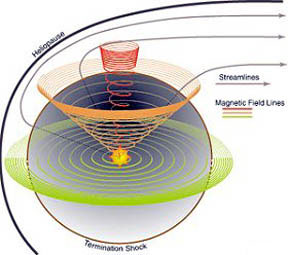 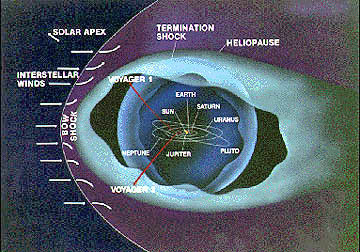 But if the "Sun-Spot Cycle" is 11 years, and if this "Solar Magnetic Cycle" will "change again" in 2012, as NASA states, or 11 years from now, then the next solar magnetic "flip-flop" will occur in February 2012, simultaneously with the next Chinese Year Of The Dragon. Then later that year, the current Mayan Tzolkin Calendar will "come to an end" on 21 December, the Winter Solstice, when the Earth-Sun alignment coincides again with Sagittarius' "Black Road"; and by the commencement of the Chinese Year Of The Snake in early 2013 CE, we shall already be into the early days of the new "Mayan Tzolkin Era"! To me personally, these are significant and exciting "correlations". You yourself will ultimately have to decide how you interpret this information. But it indicates that a "long cycle" (exactly like the Mayas described!) will be coming to an end in 2012, when an 11 X 3,600-year period renews itself once again, simultaneously. And it is very difficult to argue with all these historical mathematics. Finally, here in this NASA article once again we are faced with the paradox concerning the geological dating versus the historical dating. It is simply historically untrue and inaccurate that the last shift of the Earth's magnetic poles occurred about 740,000 years ago. To be more precise, it occurred exactly 3,588 years ago from early 2001. As I have pointed out time and again, one simply cannot straddle the fence in these mathematical matters. Either one accepts the Velikovskian Historical Reconstruction, or one does not. Time itself will eventually select the winning side of "The Velikovsky Affair"!
The Sun Does a
Flip February 15, 2001 -- You can't tell by looking, but scientists say the Sun has just undergone an important change. Our star's magnetic field, which extends through the distant reaches of interplanetary space, has flipped. The Sun's magnetic north pole, which was in the northern hemisphere just a few months ago, now points south. It's a topsy-turvy situation, but not an unexpected one. "This always happens around the time of solar maximum," says David Hathaway, a solar physicist at the Marshall Space Flight Center. "The magnetic poles exchange places at the peak of the sunspot cycle. In fact, it's a good indication that Solar Max is really here."
The Sun's magnetic poles will remain as they are now, with the north magnetic pole pointing through the Sun's southern hemisphere, until the year 2012 when they will reverse again. This transition happens, as far as we know, at the peak of every 11-year sunspot cycle -- like clockwork. Earth's magnetic field also flips, but with less regularity. Consecutive reversals are spaced 5 thousand years to 50 million years apart. The last reversal happened 740,000 years ago. Some researchers think our planet is overdue for another one, but nobody knows exactly when the next reversal might occur. Although solar and terrestrial magnetic fields behave differently, they do have something in common: their shape. During solar minimum the Sun's field, like Earth's, resembles that of an iron bar magnet, with great closed loops near the equator and open field lines near the poles. Scientists call such a field a "dipole." The Sun's dipolar field is about as strong as a refrigerator magnet, or 50 gauss (a unit of magnetic intensity). Earth's magnetic field is 100 times weaker.
When solar maximum arrives and sunspots pepper the face of the Sun, our star's magnetic field begins to change. Sunspots are places where intense magnetic loops -- hundreds of times stronger than the ambient dipole field -- poke through the photosphere. "Meridional flows on the Sun's surface carry magnetic fields from mid-latitude sunspots to the Sun's poles," explains Hathaway. "The poles end up flipping because these flows transport south-pointing magnetic flux to the north magnetic pole, and north-pointing flux to the south magnetic pole." The dipole field steadily weakens as oppositely-directed flux accumulates at the Sun's poles until, at the height of solar maximum, the magnetic poles change polarity and begin to grow in a new direction. Hathaway noticed the latest polar reversal in a "magnetic butterfly diagram." Using data collected by astronomers at the U.S. National Solar Observatory on Kitt Peak, he plotted the Sun's average magnetic field, day by day, as a function of solar latitude and time from 1975 through the present. The result is a sort of strip chart recording that reveals evolving magnetic patterns on the Sun's surface. "We call it a butterfly diagram," he says, "because sunspots make a pattern in this plot that looks like the wings of a butterfly." In the butterfly diagram, pictured below, the Sun's polar fields appear as strips of uniform color near 90 degrees latitude. When the colors change (in this case from blue to yellow or vice versa) it means the polar fields have switched signs.
Above: In this "magnetic butterfly diagram," yellow regions are occupied by south-pointing magnetic fields; blue denotes north. At mid-latitudes the diagram is dominated by intense magnetic fields above sunspots. During the sunspot cycle, sunspots drift, on average, toward the equator -- hence the butterfly wings. The uniform blue and yellow regions near the poles reveal the orientation of the Sun's underlying dipole magnetic field. [more information] The ongoing changes are not confined to the space immediately around our star, Hathaway added. The Sun's magnetic field envelops the entire solar system in a bubble that scientists call the "heliosphere." The heliosphere extends 50 to 100 astronomical units (AU) beyond the orbit of Pluto. Inside it is the solar system -- outside is interstellar space. "Changes in the Sun's magnetic field are carried outward through the heliosphere by the solar wind," explains Steve Suess, another solar physicist at the Marshall Space Flight Center. "It takes about a year for disturbances to propagate all the way from the Sun to the outer bounds of the heliosphere." Because the Sun rotates (once every 27 days) solar magnetic fields corkscrew outwards in the shape of an Archimedian spiral. Far above the poles the magnetic fields twist around like a child's Slinky toy.
Because of all the twists and turns, "the impact of the field reversal on the heliosphere is complicated," says Hathaway. Sunspots are sources of intense magnetic knots that spiral outwards even as the dipole field vanishes. The heliosphere doesn't simply wink out of existence when the poles flip -- there are plenty of complex magnetic structures to fill the void. Or so the theory goes. ... Researchers have never seen the magnetic flip happen from the best possible point of view -- that is, from the top down. But now, the unique Ulysses spacecraft may give scientists a reality check. Ulysses, an international joint venture of the European Space Agency and NASA, was launched in 1990 to observe the solar system from very high solar latitudes. Every six years the spacecraft flies 2.2 AU over the Sun's poles. No other probe travels so far above the orbital plane of the planets. "Ulysses just passed under the Sun's south pole," says Suess, a mission co-Investigator. "Now it will loop back and fly over the north pole in the fall."
"This is the most important part of our mission," he says. Ulysses last flew over the Sun's poles in 1994 and 1996, during solar minimum, and the craft made several important discoveries about cosmic rays, the solar wind, and more. "Now we get to see the Sun's poles during the other extreme: Solar Max. Our data will cover a complete solar cycle." To learn more about the Sun's changing magnetic field and how it is generated, please visit "The Solar Dynamo," a web page prepared by the NASA/Marshall solar research group. Updates from the Ulysses spacecraft may be found on the Internet from JPL at http://ulysses.jpl.nasa.gov/. |
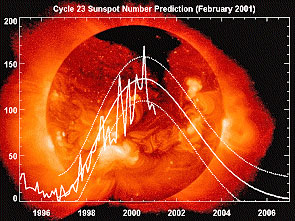 Left: Sunspot counts, plotted here against
an x-ray image of the Sun, are nearing their maximum for the current
solar cycle. [more information]
Left: Sunspot counts, plotted here against
an x-ray image of the Sun, are nearing their maximum for the current
solar cycle. [more information]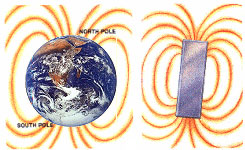 Right: The Sun's basic magnetic field, like
Earth's, resembles that of a bar magnet.
Right: The Sun's basic magnetic field, like
Earth's, resembles that of a bar magnet.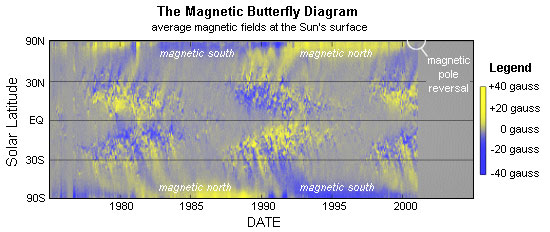
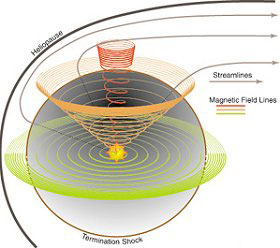 Left: Steve Suess (NASA/MSFC) prepared this
figure, which shows the Sun's spiraling magnetic fields from a
vantage point ~100 AU from the Sun.
Left: Steve Suess (NASA/MSFC) prepared this
figure, which shows the Sun's spiraling magnetic fields from a
vantage point ~100 AU from the Sun.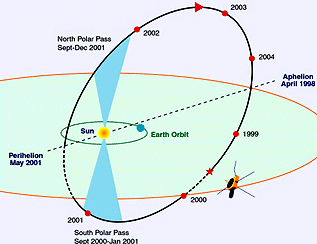 Right: Following an encounter with Jupiter
in 1992, the Ulysses spacecraft went into a high polar orbit.
It's maximum solar latitude is 80.2 degrees south. [more]
Right: Following an encounter with Jupiter
in 1992, the Ulysses spacecraft went into a high polar orbit.
It's maximum solar latitude is 80.2 degrees south. [more]